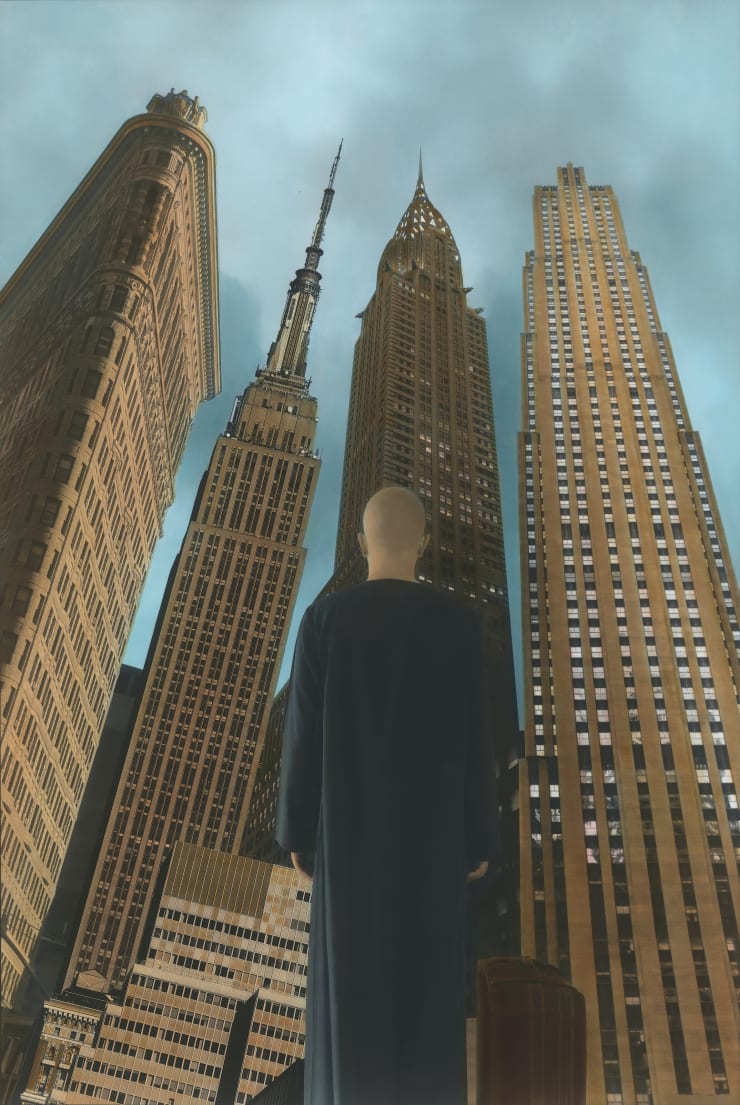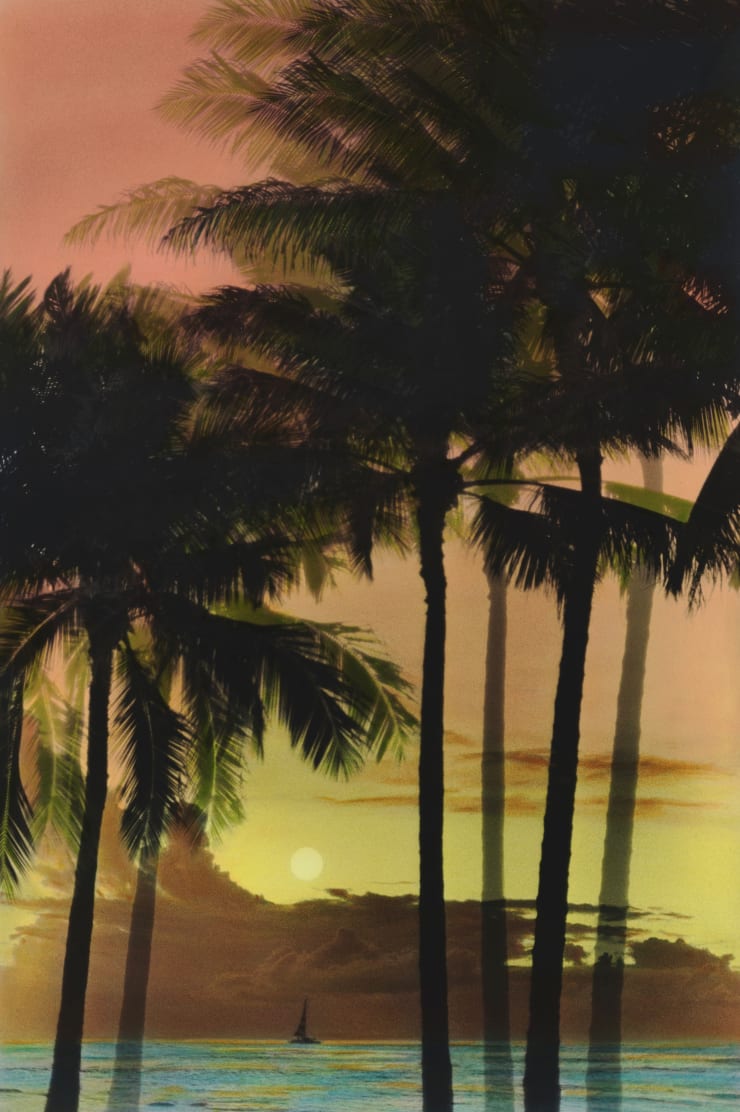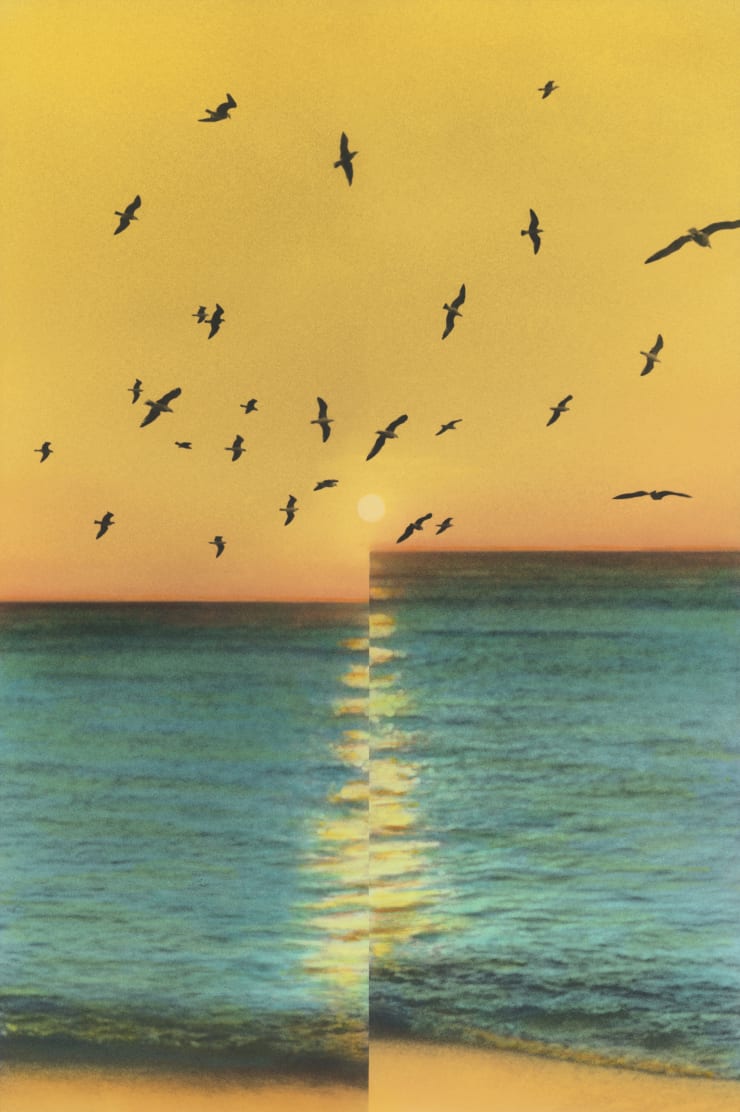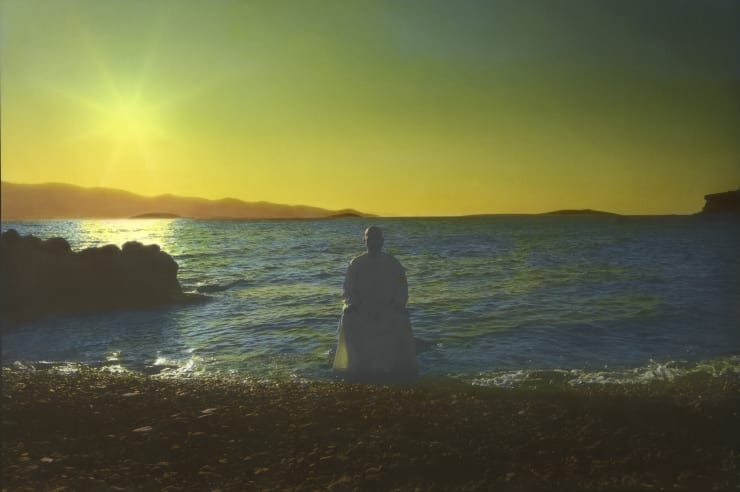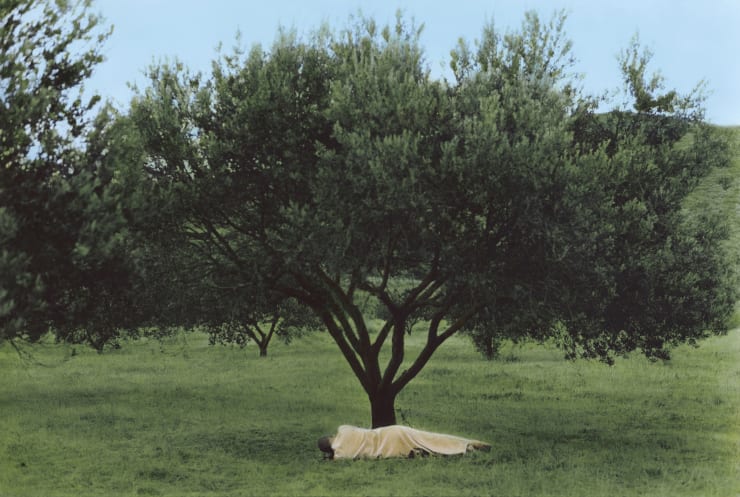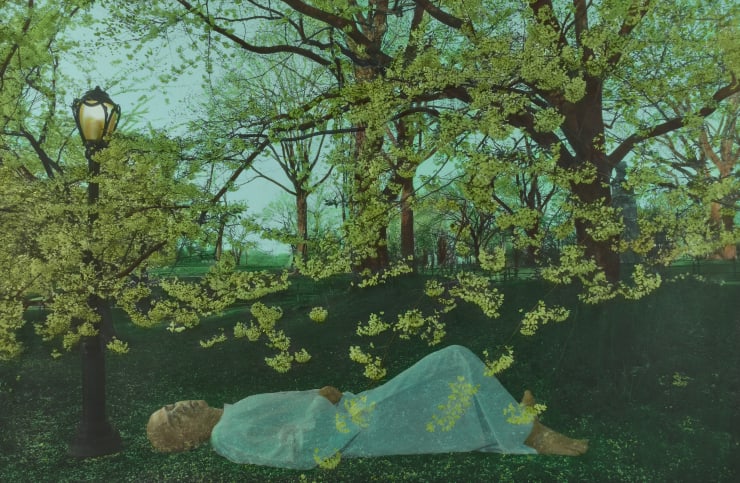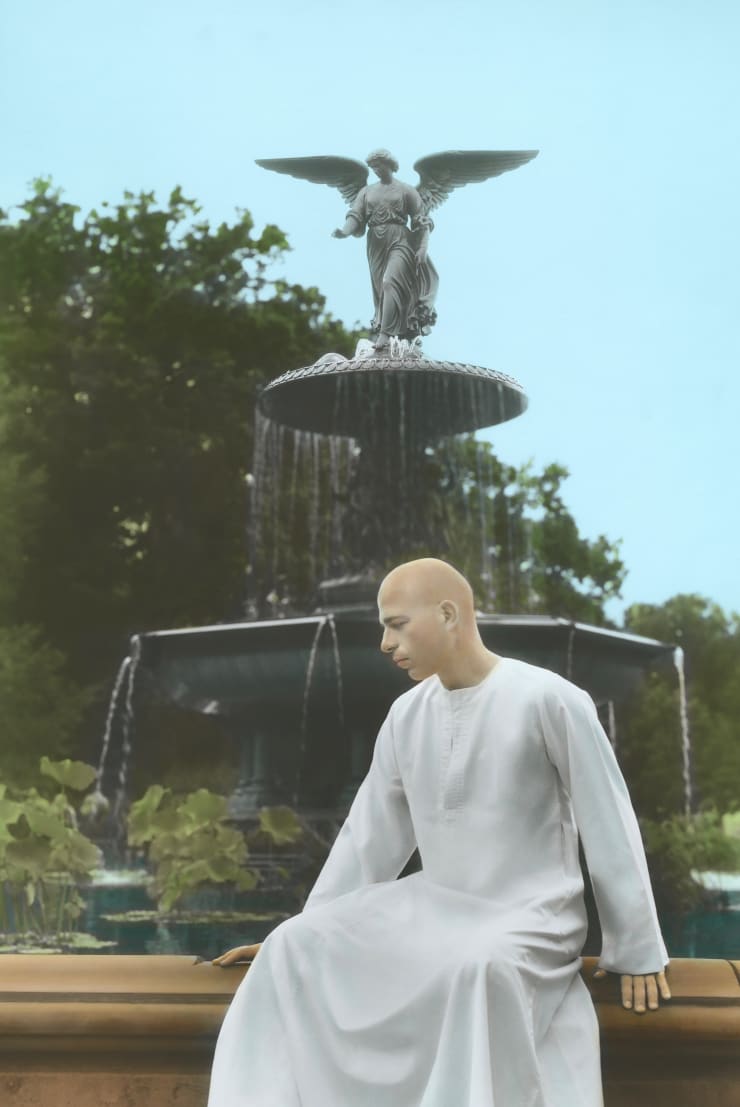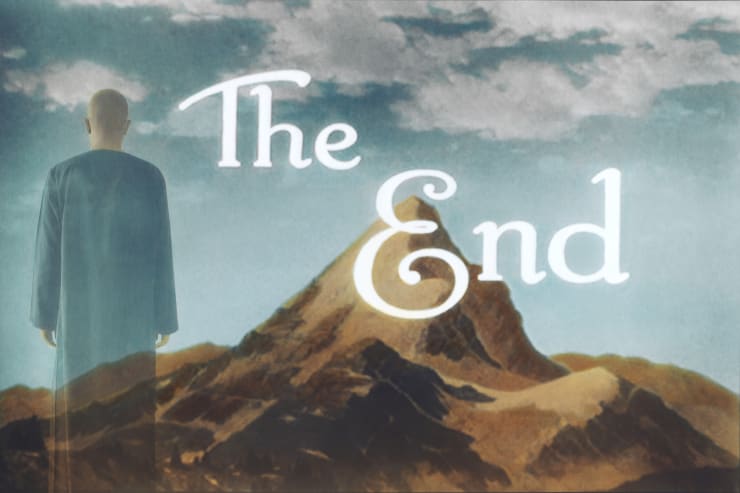-
Youssef Nabil
The Beautiful Voyage
22nd September - 28th October, 2022
-
The Third Line is pleased to announce a solo exhibition by internationally acclaimed artist Youssef Nabil. The Beautiful Voyage presents a curated selection of recent works including photographs of cinematic landscapes and imaginary self-portraits, as well as the regional debut of Nabil’s fourth video, also called The Beautiful Voyage.
-
SOME THOUGHTS ON YOUSSEF NABIL’S
"THE BEAUTIFUL VOYAGE" EXHIBITION
Words by Bob Colacello
-
Youssef Nabil is an Egyptian artist who lives and works between Paris and Harlem. His work encompasses the ancient wisdom of the Nile Valley, the opulent refinement of the City of Lights, and the high-voltage glamour of Black uptown Manhattan. It is serene and poetic, lush and sensuous, a mélange of complementary and competing elements, fusing and combining to create a quasi-divine contemplation of longing and desire. Like all great art it makes no sense and perfect sense, it surprises, haunts, and seduces.
Its uniqueness lies first in its technique: the superimposition by the artist's hand of gorgeously saturated colors over impeccably composed silver gelatin prints - of painting over photography, the human over the machine, the timeless over the immediate.
The works on view at The Third Line gallery in Dubai - cinematic landscapes and imaginary self-portraits, as well as Nabil's fourth video, also called "The Beautiful Voyage", featuring the actress Charlotte Rampling - affirm and heighten his stature as an artist who both represents and transcends his times. A rather remarkable accomplishment in this hyper politicized, all-or-nothing day and age.
This is not to say these works are not relevant, or overly antique. Nabil had his first solo in 1999, at age 27, in Cairo. In 2001, on a trip to Egypt, the superstar British artist Tracey Emin discovered his work and, in a Harper's magazine article, predicted he would become one of the top artists of his generation. Over the past two decades he has done portraits of many of the most formidable figures in art, film and music. From Louise Bourgeois to Marina Abramović. DeNiro to Deneuve, Alicia Keys to Sting. His work hangs in the Los Angeles County Museum of Art, The British Museum, the Guggenheim Abu Dhabi, the Studio Museum in Harlem, the Francois Pinault Collection in Paris, the Louis Vuitton Foundation, also in Paris, and too many other international institutions to mention. This is all to say he is in the middle of everything au courant and cutting edge.
Yet, a dreamy sense of memory, a sort of surrealist mist or veil, something Daliesque, a hint of Frida Kahlo, hangs over everything he does. And that only makes it more complex. Mysterious, compelling, richer.
In its beauty and strength - and the sense that this will last - Nabil's work brings to mind Matisse's 1904 Fauvist masterpiece, "Luxe, Calme et Volupté”. Matisse took his title from Baudelaire's 1857 book of poetry, “Les Fleurs du Mal”. Translated into English from the original French, the appropriated lines read:
There, all is order and beauty,
Luxury, peace and pleasure.
The title of the particular poem that contains those lines is "L’invitation au voyage".
Sail on...
--- Bob Colacello — Southampton, New York, 2022
-
-
"Its uniqueness lies first in its technique: the superimposition by the artist's hand of gorgeously saturated colors over impeccably composed silver gelatin prints - of painting over photography, the human over the machine, the timeless over the immediate." Bob Colacello
-
The Landscape of Our Memories:
Recent Works by Youssef Nabil
Words by Layla S. Diba
-
Heureux qui comme Ulysse a fait un beau voyage ou comme cestuy lá qui conquit la toison et puis est retourné, plein d’usage et raison, vivre entre ses parents le reste de son âge. (https:www.bacdefrancais.net, accessed July 20, 2022)
-
This melancholy refrain by the celebrated French poet Joachim du Bellay (1522-66) finds a poignant echo centuries later in The Beautiful Voyage, the most recent work of a modern Ulysses, Youssef Nabil. Yet unlike du Bellay, Nabil does not offer a vision of a happy return to home and hearth, in this case Egypt, but rather an unending voyage across the artist’s imaginary. Nabil’s latest video installation is a poetic and ultimately shattering meditation on love, life, memory, death and exile.
FADE IN…
A woman lies asleep in an interior space, dreaming. Soft music plays in the background, accompanied by the soothing sound of waves. The scene shifts to an eternal twilight by the sea, where a ghostly figure sits waiting. Waiting to depart or to return we do not know. The elegiac mood of the eight-minute video is established by a feminine voice reciting in Arabic verses from Ithaka,perhaps the most celebrated poem by Constantine P. Cavafy, the Alexandrian Greek poet (1863-1933). The verses sing of the importance of life’s journey rather than of its end and set a hopeful tone. The poem is especially poignant since it evokes Nabil’s childhood – a joyful and nostalgic memory of a lost time. Later in the video, we learn it is the voice of the artist’s Mother, who is said to have often recited these same verses to him as a boy growing up in Cairo.
In the following scene, the actress Charlotte Rampling delivers a monologue, telling Nabil’s story. The two protagonists lie in a bathtub in a ghostly bathroom seated far apart, together yet separate. Both figures are archetypes: Rampling the eternal Mother and Nabil the spectral figure of Egyptian lore and son. In her dream, Rampling reassures the artist that he never truly left his loved ones or his country, that life is a journey, a dream, that his true home is movement and that the dead are never truly lost to us. The words are the artist’s own, the first script he has written and published, and represent a moving summation of the wisdom he has acquired through the years as an outsider in an ever-changing and unsettled world, which resonates deeply with many viewers. The video ends with Rampling asleep in her bed and Nabil quietly standing by the door poised to depart. It is an exceptionally beautiful and moving conversation – a moment of intimacy and contemplation between two loving friends.
FADE TO BLACK…
-
-
Twenty-one hand coloured gelatin silver prints accompany the video, which is at the beating heart of the installation. The photographs present a curated selection of Nabil’s works from 2016 to the present.
He is his own best subject: self-portraits of the artist are set in reimagined landscapes and seascapes from New York to Monterrey and Greece. The settings seem familiar yet are strangely undefined, united only by the presence of the artist and his memories of place. The figure of the artist evokes that of other celebrated outsiders, such as the Zelig-like Jewish author Lev Nussenbaum (1905-42), who adopted the persona of a Muslim writer known as Kurban Said, in order to pen one of the most popular pre-war romance novels, Ali and Nino. The artist’s figure also recalls the Palestinian public intellectual Edward Said, whose transformative work reimagined the field of Orientalism: all three have navigated successfully between worlds and produced their greatest works as exiles.
Another theme is nostalgia for an Orientalist fantasy of ancient Egypt and the golden age of modern Egyptian cinema and culture, when a local form of Surrealism emerged, the celebrated artist Umm Kulthum sang and exotic belly dancers performed. The fantasy of Egypt as a verdant green landscape or a fertile oasis of palm trees amid an arid land is referenced by a number of the photographs in this series although none are set in Egypt, as the titles affirm.
A sense of loss is also a favored leitmotiv, symbolized by Nabil’s frequent choice of twilight as the setting for his compositions. Yet we feel the artist’s ultimate acceptance of his identity as a nomad wandering the earth.
The cinematic quality of Nabil’s vision is referenced in this series by his use of words in a subtitle form and of transparency. His enduring interest in film is visualized by a self-portrait inserted into the end credits of a film – as if Nabil’s life was also only a movie.
From an art historical perspective, Nabil’s work is informed not only by the local art and culture of the Middle East, but by a profound admiration of Western art. In the video entitled You Never Left (2010), a veiled woman portrayed by Fanny Ardant cradles a young Christ-like figure, played by Tahar Rahim, in her arms. The image strikingly evokes the sculpture of Michelangelo’s Pieta. In another instance, Nabil has pictured himself reclining in front of Botticelli’s Primavera.
-

-
Nabil uses appropriation skillfully, sampling from a range of works from across the visual arts. The setting of the video evokes Stanley Kubrick’s last scene in his masterwork 2001: A Space Odyssey which is set in a modern impersonal hotel room furnished with antiques and uses a similar soft muted color palette. The image of the two figures in the bathtub is mysterious and puzzling, Nabil himself explains that he intended to add a dimension of Surrealism, intimacy and sensuality to the work (Nabil email to the author, July 3 2022). Both the meaning of the motif and the formal model of the composition remain open to different interpretations, yet its prototype may ultimately be traced to Renaissance painting, such as in Botticelli’s Venus and Mars.
Nabil’s artistic journey has been a long and ultimately fruitful one. Beginning in the early 1990s he developed his signature style. Consisting primarily of portraits and self-portraits referencing the work of his friend and mentor the Armenian-Egyptian photographer and film buff of the 1950s, Van Leo (1921-2002). Van Leo’s black and white photographic subjects were the luminaries and celebrities of modern Egypt of the 1940s-50s, when Cairo was known as ‘Hollywood on the Nile’. Nabil later worked with distinguished photographers in the 1990s in New York and Paris.
Yet Nabil’s photographs developed an original visual language grounded in a reimagined Orientalism, as evidenced by his hand colored black and white prints evoking late 19th and early 20th century Colonial era photography. The hand tinting technique was still current in Cairo in the 1980s and 1990s, the formative period of Nabil’s career.
Nabil’s use of appropriation and transformation was a strategy he shared with contemporary Middle Eastern as well as global artists of the 1990s. Artists ranging from Chant Avedissian to Ghasem Hajizadeh have explored Middle Eastern and Iranian pop culture as a source of inspiration, while Nabil’s work is also in dialogue with that of Shirin Neshat and Cindy Sherman and artists of the picture generation.
Nabil’s celebrity portraits were evocative and glamorous, yet a close reading of his early self-portraits and landscapes reveals a deeper side of his personality. By way of example, the 2010 video You Never Left explored similar themes of longing and separation to those in The Beautiful Voyage (2021). The video presages the present work, yet the imagery is rooted in the Arab soil, whereas The Beautiful Voyage (2021), by moving beyond the local to the global, presents a cosmopolitan vision.
The Beautiful Voyage (2021) is both personal and universal: the image of the wanderer, with an uncertain future, facing the Mediterranean, not only a space of dialogue between cultures, but also a space of shared memories of the massive immigration to Europe from the shores of Africa since the Arab Spring of 2011; of the covid crisis; and, in a larger sense, of the crisis of humanity torn by wars, revolutions, and diaspora. Yet the work goes beyond the usual facile statements of political and social outrage. It offers a moment of peace and serenity at the end of the long journey we have all undertaken. The covid era presented Nabil with the opportunity to reflect anew on major philosophical issues he had explored in the past, and his new work movingly shares the end of this voyage with us.
It is this transformation of the artist as well as of the human being, which sometimes leaves the viewer in tears, and which ultimately elevates these works beyond the realm of art to that of an almost religious experience. By presenting us with these landscapes of our shared memories, Nabil offers us all a vision of hope in a constantly changing world, in which he argues, home is within each of us.
New York
July 2022
References
https:www.bacdefrancais.net, accessed July 20, 2022
Youssef Nabil, email correspondence with the author, July 3, 2022
Youssef Nabil, email correspondence with the author, July 15, 2022
-
-
Worklist
-
 Youssef NabilThe Visitor, self-portrait, 2021Hand Coloured Gelatin Silver Print115 x 75 cmEdition of 5
Youssef NabilThe Visitor, self-portrait, 2021Hand Coloured Gelatin Silver Print115 x 75 cmEdition of 5 -
 Youssef NabilYour Life was just a Dream, 2019Hand Coloured Gelatin Silver Print115 x 75 cmEdition of 5
Youssef NabilYour Life was just a Dream, 2019Hand Coloured Gelatin Silver Print115 x 75 cmEdition of 5 -
 Youssef NabilConnected to you by every Sea, self-portrait, 2021Hand Coloured Gelatin Silver Print26 x 39 cmEdition of 10
Youssef NabilConnected to you by every Sea, self-portrait, 2021Hand Coloured Gelatin Silver Print26 x 39 cmEdition of 10 -
 Youssef NabilNo one knows but the Sky, 2019Hand Coloured Gelatin Silver Print115 x 75 cmEdition of 5
Youssef NabilNo one knows but the Sky, 2019Hand Coloured Gelatin Silver Print115 x 75 cmEdition of 5 -
 Youssef NabilThe Beautiful Voyage, self-portrait, Antiparos, 2021Hand Coloured Gelatin Silver Print
Youssef NabilThe Beautiful Voyage, self-portrait, Antiparos, 2021Hand Coloured Gelatin Silver Print -
 Youssef NabilSelf-portrait with Pyramid ( II ), Mexico City, 2018Hand Coloured Gelatin Silver Print
Youssef NabilSelf-portrait with Pyramid ( II ), Mexico City, 2018Hand Coloured Gelatin Silver Print -
 Youssef NabilThe Language of Dreams, self-portrait, Monterrey, 2018Hand Coloured Gelatin Silver Print
Youssef NabilThe Language of Dreams, self-portrait, Monterrey, 2018Hand Coloured Gelatin Silver Print -
 Youssef NabilSelf-portrait with an Olive Tree, Kéa, 2016Hand Coloured Gelatin Silver Print26 x 39 cmEdition of 10
Youssef NabilSelf-portrait with an Olive Tree, Kéa, 2016Hand Coloured Gelatin Silver Print26 x 39 cmEdition of 10 -
 Youssef NabilYour Heart Knows The Way, 2019Hand Coloured Gelatin Silver Print115 x 75 cmEdition of 5
Youssef NabilYour Heart Knows The Way, 2019Hand Coloured Gelatin Silver Print115 x 75 cmEdition of 5 -
 Youssef NabilGoodbye to All that, self-portrait , 2021Hand Coloured Gelatin Silver Print26 x 39 cmEdition of 10
Youssef NabilGoodbye to All that, self-portrait , 2021Hand Coloured Gelatin Silver Print26 x 39 cmEdition of 10 -
 Youssef NabilHere to Go, 2019Hand Coloured Gelatin Silver Print37.06 x 25.2 cmEdition of 10
Youssef NabilHere to Go, 2019Hand Coloured Gelatin Silver Print37.06 x 25.2 cmEdition of 10 -
 Youssef NabilSelf-portrait in the Park, New York, 2021Hand Coloured Gelatin Silver Print
Youssef NabilSelf-portrait in the Park, New York, 2021Hand Coloured Gelatin Silver Print -
 Youssef NabilSelf-portrait with an Angel ( II ), New York, 2021Hand Coloured Gelatin Silver Print
Youssef NabilSelf-portrait with an Angel ( II ), New York, 2021Hand Coloured Gelatin Silver Print -
 Youssef NabilTHE END ( III ), self-portrait, 2021Hand Coloured Gelatin Silver Print
Youssef NabilTHE END ( III ), self-portrait, 2021Hand Coloured Gelatin Silver Print -
 Youssef NabilThe Dream, self-portrait, 2021Hand Coloured Gelatin Silver Print29.10 x 36.50 cmEdition of 10
Youssef NabilThe Dream, self-portrait, 2021Hand Coloured Gelatin Silver Print29.10 x 36.50 cmEdition of 10 -
 Youssef NabilSelf-portrait with the Moonlight, 2021Hand Coloured Gelatin Silver Print75 x 116 cmEdition of 5
Youssef NabilSelf-portrait with the Moonlight, 2021Hand Coloured Gelatin Silver Print75 x 116 cmEdition of 5
-
-
About Bob Colacello
Bob Colacello was born in Brooklyn, NY, and raised on Long Island. He graduated from Georgetown School of Foreign Service in 1969, and Columbia Graduate School of the Arts in 1971 with an MFA in Film. By then he had been hired to run Andy Warhol’s new magazine, Interview, a job he held for thirteen years, becoming one of the artist’s closest creative collaborators. His memoir of that period, Holy Terror: Andy Warhol Close Up, was published in 1990.
From 1984 to 2017, Colacello was under exclusive contract to Vanity Fair, covering cultural, social, and political subjects. In 2004, he published a biography of the Reagans, Ronnie and Nancy: Their Path to the White House. He has published two books of his photographs from the 1970s and 1980s: Bob Colacello’s OUT from 7L Steidl in 2007; and It Just Happened from Ivorypress in 2021.
Since 2015, Colacello has been a Senior Advisor at Vito Schnabel Gallery. Colacello was named Associate Director of the Peter Marino Art Foundation in Southampton, New York in 2021.
-
About Layla S. Diba
Layla S. Diba is an independent art advisor, scholar and curator specializing in the art of 19th and 20th century Iran. She has been the Director and Chief Curator of the Negarestan Museum of 18th and 19th century Iranian Art in Tehran from 1975-78. She served as the Curator of Islamic Art at the Brooklyn Museum of Art from 1990-2000 where she organized the exhibition Royal Persian Paintings: The Qajar Epoch (1785-1925). In 2013, Dr. Diba co-curated Iran Modern at the Asia Society in New York, the first major exhibition of modern art from Iran that featured 26 artists and covered a period of time from 1948 through to 1977.
Dr. Diba has also collaborated with the Guggenheim Abu Dhabi Museum and the Metropolitan Museum of Art in New York and sits on the Boards of the Soudavar Memorial Foundation and of The National Museum of Asian Art, Charles Lang Freer and Arthur M. Sackler Galleries, Washington. In 2009, Dr. Diba held the role of Scholar-in-Residence at Shangri La Museum of Islamic Art, Culture & Design.
Current projects include the publication of Art in Peril: The Case of the Negarestan Museum and its Collections of 18th and 19th century Iranian Art.


